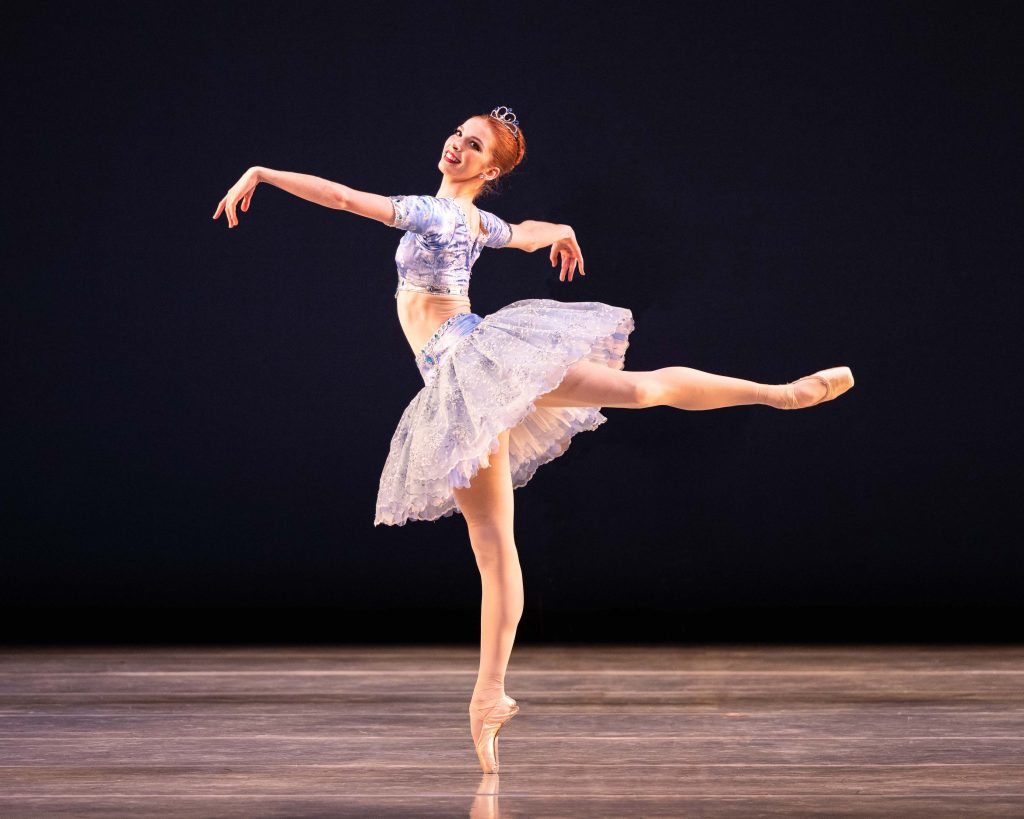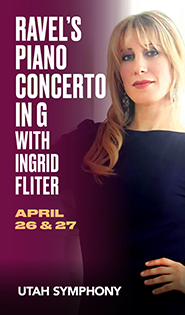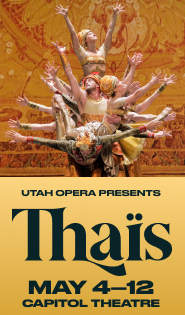Ballet West sparkles in “Precious Gems”

Aladdin. Photo: Beau Pearson
Five months have passed since Ballet West danced for a live audience at the Capitol Theatre. “Precious Gems,” the title of the company’s spring program, captures both the rarity of live performances such as these in pandemic times and the dazzling work on display in Ballet West’s return to the stage.
The theater auditorium is at 20 percent capacity for the two weekends of shows, but a feeling of gratitude and exhilaration filled the room on Friday evening as patrons applauded both the performance and the occasion. Dancers and audience alike seemed invigorated by the 90-minute program (without intermission) of eight pieces.
“Precious Gems” was deeply enriched by the presence on Friday of Jared Oaks, the company’s music director, who conducted the Ballet West Orchestra for two pieces: Aria, choreographed by Val Caniparoli to Handel’s Overture from “Rinaldo”; and Duet from Concerto Six Twenty-Two, choreographed by Lar Lubovitch to Mozart’s Concerto for Clarinet and Orchestra in A Major. Both pieces are new to Ballet West and bring gravitas to a program that otherwise favors flashy pieces and glittery displays.
The performance opened with an excerpt from Aladdin called “Precious Jewels Variations,” choreographed by Pamela Robinson-Harris and Peggy Dolkas, to music by Dvořák, Grieg and Kouchyar Shahroudi. The evening closed with Paquita, choreographed by Elena Kunikova after Marius Petipa, to music by Ludwig Minkus, Riccardo Eugenio Drigo and Nikolai Tcherepnin. To abide by social distancing protocols, the corps de ballet in Paquita was only six women, who were joined by two soloists, Olivia Gusti and Lindsay Bond, plus the principals, Beckanne Sisk and Chase O’Connell.
In between these larger cast pieces, the rest of the performance consisted of solos, duets, and a quartet. The program is the same for every show except for one solo piece: George Balanchine’s “Sicilienne” from Emeralds will alternate with Gerald Arpino’s “Schnofler Tanz” from Kettentanz.
While the choreography spans more than a century — from Paquita, which had its premiere in the 19th Century, to Aladdin, made in 2013 — the dancers on Friday generated a seamless through-line, and brought nuance and joy to their virtuosity.
Balanchine’s Tarantella was danced with beauty and charm by Jenna Rae Herrera and Joshua Whitehead. In the solo from Caniparoli’s Lambarena, Katlyn Addison merged music and choreography to create a gorgeous evocation of celebration and creativity. In a particularly unforgettable moment, she stalked on her pointe shoes, her rib cage pulsing as if her heart were propelling the drumbeat. This choreography, created in 1995 in collaboration with Naomi Gedo Diouf and Zakarya Sao Diouf, is set to musical selections from Bach and traditional African music as arranged by Pierre Akendengué of Gabon and Hughes de Courson of France.
Lambarena is in the repertory of more than a dozen ballet companies and its first cast included Evelyn Cisneros, a principal with San Francisco Ballet in 1995. In 2020, Cisneros joined Ballet West as director of Ballet West Academy. These relationships emphasize the interconnectedness of dancers, companies and schools, and how ballet continually evolves as generations introduce new choreography and performance qualities. It was fitting, then, that Addison performed the celebratory solo from Lambarena on Friday: Her promotion was just announced, and next year she will be a Principal Artist.
“Precious Gems” includes three pieces that are new additions to Ballet West’s repertory. Caniparoli’s Aria, first performed in 1997, was danced with grace and poignancy on Friday by Adrian Fry. Although Aria is a solo, Fry’s use of a white face mask — by Ballet West property manager Cory Thorell — transformed the dancer into different characters, or perhaps different facets of the same person. Aria eerily reflected our present moment, as all Capitol Theatre patrons are required to wear masks throughout the season.
Fry’s dancing suggested feelings of confinement and isolation: He repeatedly clasped his hands behind his back, arching his chest skyward, and then leaned his torso towards the ground. Mezzo-soprano Aubrey Adams-McMillan enriched these performances with a voice that blossomed and soared through Handel’s Overture. This Aria was a fascinating reminder that every performance is a new version of the choreography, dependent on its context, performers and era.
Another addition to Ballet West’s repertory this spring is Sir Anton Dolin’s Variations for Four. Set to music by Marguerite Keogh, this quartet dating to 1957 is technically challenging and distinguished by its subtlety and Apollonian character — formal, understated and precise.
Friday’s cast rose to the occasion. The role of “Earth” was danced by Hadriel Diniz (he too will be promoted to Principal Artist next year); the role of “Air” was performed by David Huffmire; “Fire” was Tyler Gum, and “Water” was performed by Jordan Veit.
Veit danced with calm and impressive prowess, while Gum executed rapid-fire phrases and intricate jumps. Huffmire brought brilliance to a sequence of pirouettes that finished with exquisitely balanced extensions, and Diniz dazzled in multiple jumps called entrechat six. Embodying different qualities of natural elements, the dancers showcased distinct styles while also maintaining a beautiful sense of unison. The quartet was a testament to perseverance, unity, and interdependence, qualities that seem vital during a global pandemic.
“Precious Gems” will be repeated through April 17. balletwest.org

